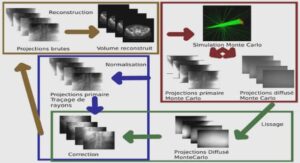In recent years, financial markets worldwide became highly integrated, overcoming national borders. The problem of developing adequate tools and comprehensive approaches for achieving higher security and stability in the EU financial sector is on the agenda. Key issues and challenges for the formation and development of the single European financial market, driven by the new realities, are considered in this thesis.
The goal of this thesis is to propose and develop analyses able to contribute to the transformation of the banking system. The current state of the system is a structure with delayed-in-time management. In this system, the impact of the regulatory measures and interventions in response to a particular problem is delayed in the time due to the structure of the market and the periodicity of information gathering. The Aim of this dissertation is to transform the system into an operational self-regulating system (system of systems) operating in near real-time. This transformation would allow sharp increase in stability and operability of the system.
In connection with the defined goal and for solving the research thesis, in the dissertation is applied theoretical methods like mathematical models, simulation modeling and systemic approach under which the analyzed object is regarded as a system with defined elements and internal and external connections, which influence the functioning of the system. The systemic approach is deemed as the most robust foundation for management of complex interconnected activities, which allows the discovery and analysis of the different elements and their dependence.
The dissertation employs also and architectural approach, which allows the representation of a clear picture of an object or a system, such as of a specific function of a system. This approach gives a fixed description of the functional interdependencies in the system under the form of models. The main goal of the architectural approach is to optimize the interdependencies and internal interactions in the system by creating an appropriate infrastructure.
A comparative and Data Envelopment Analysis (DEA), are employed also. The use of network-centric and multi-agent approaches is proposed for protection of the critical banking infrastructure and the creation of a supranational network supervisory architecture.
The network-centric concept is based on the principle of self-synchronization specific to the theory of complex systems. The essence is that complex phenomena and structures are best organized bottom-up. The agent-based modeling is a powerful simulation modeling technique that has seen a number of applications in the last few years, including applications to real-world business problems (Bonabeau, 2002).
In recent years there have been significant changes in the structure of institutions responsible for supervision of the financial system. Given the predominantly strong influence of the banking markets in Europe in historical perspective, the development of financial markets over the past two decades leading to increased importance of insurance companies and investment and pension funds raised the issue of supervision of non-bank financial institutions and investor protection. As a result of these changes the current supervisory architectures are increasingly more diverse. In some countries there is the classic vertical model with separate supervisory bodies for banking, insurance and securities markets (Spain, Italy, Greece). In some cases, a unified supervision outside the Central bank has been established (example: England, Germany, Hungary), while in other countries (Czech Republic, Ireland and Slovakia) the Central bank is the unified supervisory authority. Among EU countries only the Netherlands has adopted the horizontal « twin peaks » model.
A survey conducted by the European Central bank in 2003 highlights some similarities in the reforms of the national supervisory authorities: a stronger commitment of the Central banks to the supervisory process, even when they are not directly assigned such powers; an increased tendency for interaction between supervisors, contributing to financial stability.
At the European level, the period 2003-2006 was characterized by enhanced interaction between supervisors. In particular, the Lamfalussy structure was extended to cover not only the securities market, but also the banking and insurance sectors: the third level of the structure includes three sectoral committees with representatives of the national supervisory authorities, where the objective is to intensify the supervisory and regulatory convergence in the EU. These committees have an advisory role under the European Commission. It should be noted that all Central banks participate in the third-level committee responsible for the banking sector (CEBS), whether or not they perform banking supervision function.
According to the same survey by the ECB, the national supervisory architectures depend mainly on local peculiarities such as: historical development of the financial markets, established traditions, structure of the financial sector, structure of the national government, etc.
In recent years, thirteen countries have undertaken reforms, moving from the vertical (sectoral) model to one of the other two. However, the vertical model remains one of the most popular, existing in six countries: Greece, Spain, Cyprus, Lithuania, Slovenia and Romania. In other countries, the vertical model exists with certain modifications: France (before 2010), Portugal, Finland (before 2009) and Luxembourg. As a variation of this model, in Finland and Luxembourg the supervision of banking and securities markets is integrated into a single institution. Bulgaria may also be placed under the vertical model of allocation of supervisory responsibilities.
The horizontal model, where the supervisory activities and the control of business practices are performed by different institutions (the « twin peaks » model), is fully recognized by the Netherlands , while in other Member States (Italy) only certain supervisory responsibilities constitute an implementation of the principle of the horizontal model. Elements of such allocation are also present in the supervisory structures in France and Portugal.
INTRODUCTION |





